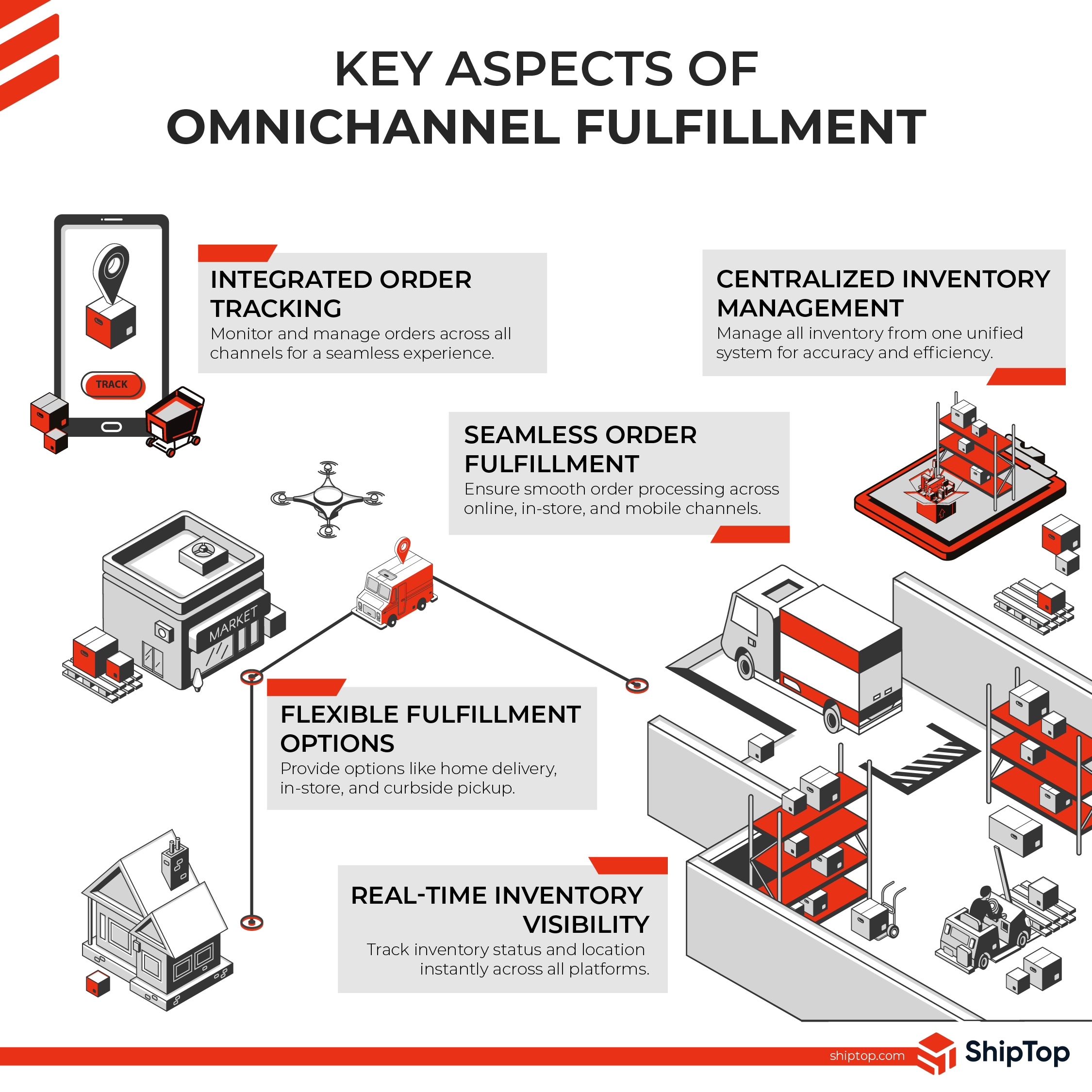These days, customers expect a seamless shopping experience, no matter how and where they interact with your brand. They want to browse online, buy in-store, and receive their purchases quickly and conveniently.
With omnichannel fulfillment, retailers can sell products through various channels — online stores, mobile apps, brick-and-mortar stores, social media, and so on. When a customer places an order, it is fulfilled from the same central inventory, regardless of which sales channel was used to purchase the item.
The goal of omnichannel fulfillment is to provide customers with a unified shopping experience by integrating processes and inventory across channels.
Let’s see how that works out in practice.
What is omnichannel fulfillment?
Omnichannel fulfillment is a strategy that integrates all sales channels — such as online stores, physical retail locations, and marketplaces — into a single, seamless system to manage inventory, orders, and deliveries.
This approach allows businesses to fulfill orders from any channel, using shared inventory and connected systems.
For example, a customer can buy a product online and pick it up in-store (BOPIS) or return an online purchase to a physical location. This way, omnichannel fulfillment ensures flexibility, efficiency, and a consistent experience for customers, no matter how or where they shop.

This approach is often confused with multichannel fulfillment. This is a completely separate term. Multichannel fulfillment manages channels separately, often leading to siloed systems and various inefficiencies. To learn more, check out our comparison of multichannel and omnichannel fulfillment.
The advantages of omnichannel order fulfillment
Traditional order fulfillment strategies tend to rely on siloed systems. Orders come in through various channels and are fulfilled from separate warehouses or inventory pools.
This leads to:
- Fragmented processes: Without a connected system, employees must constantly switch between different software, spreadsheets, and paper systems to fulfill orders.
- Lack of visibility: Since inventory, order, and fulfillment data live in disparate systems, it becomes difficult to get a unified view of order and inventory status.
- Higher costs: The lack of automation and integration leads to wasting significant time moving between systems, fixing errors, and hunting down inventory.
Omnichannel fulfillment technology provides the integration and visibility needed to solve these challenges.
Improved efficiency by unifying processes
Omnichannel fulfillment brings all your systems together, so everything runs smoother and faster. Instead of juggling multiple platforms, spreadsheets, or paper trails, your team can manage orders, inventory, and shipping from one place.
This means fewer errors, less wasted time, and a much quicker order fulfillment process. With everything connected, you can handle more orders without the chaos, making your operations more efficient and stress-free.
Greater inventory visibility
Omnichannel fulfillment relies on technology (like a modern WHS solution) to provide a clear, real-time view of your inventory across all channels and locations. Whether it’s in a warehouse, a store, or on its way to a customer, you always know where your stock stands.
This helps prevent overselling, out-of-stocks, and shipping errors — so you can confidently promise customers what’s available. Better visibility also makes it easier to optimize inventory levels, ensuring the right products are in the right place at the right time.
Lower costs through automation and integration
With systems working together, tasks like order routing, inventory updates, and shipping are handled seamlessly, cutting down on manual work and costly errors. You’ll save time, reduce labor costs, and avoid expensive fixes like expedited shipping or last-minute stock transfers.
By streamlining operations, businesses can do more with less, ultimately boosting profitability.
Better customer experience and more sales
Omnichannel fulfillment creates a seamless shopping experience that keeps customers happy and coming back. Whether they’re buying online, picking up in-store, or returning an item, the process is smooth and hassle-free.
Customers get faster, more reliable deliveries and the flexibility to shop however they prefer. A better experience not only builds trust and loyalty but also drives more sales, as satisfied customers are more likely to make repeat purchases and recommend your brand to others.
Requirements for running a successful omnichannel eCommerce fulfillment operation
To run a successful omnichannel eCommerce fulfillment operation, you need the right systems and partners in place. Two key requirements stand out:
Centralized inventory and order management system
A centralized inventory and order management system is the backbone of omnichannel fulfillment. It provides a single source of truth for order and inventory across all channels, warehouses, and stores. This real-time visibility helps you keep stock levels accurate, avoid overselling, and fulfill orders from the most efficient location.
Seamless communication across all channels
Clear communication across all channels is critical for delivering a smooth omnichannel experience. Whether customers interact with your brand online, in-store, or through customer support, every touchpoint should have access to the same up-to-date information.
This includes real-time inventory levels, order statuses, and customer details. When systems and teams are connected, customers can effortlessly switch between channels — like starting a purchase online and finalizing it in-store — without frustration.
A capable 3PL provider
While you can do everything in-house, many eCommerce businesses that try to take an omnichannel approach see more success by partnering with a 3PL.
The reason why is not a mystery. Partnering with a reliable third-party logistics provider can make omnichannel fulfillment easier and more scalable. A capable 3PL offers the infrastructure, technology, and expertise to handle warehousing, inventory management, and shipping across multiple channels.
They can help you optimize order routing, reduce delivery times, and manage peak demand — so you can focus on growing your business.
Leverage ShipTop’s omnichannel fulfillment services
ShipTop is a leading Canadian fulfillment company offering customized omnichannel fulfillment solutions. Our innovative technology platform, combined with our extensive logistics network, enables us to expertly manage complex omnichannel fulfillment programs for eCommerce brands.
Our end-to-end omnichannel fulfillment services include:
- Unified inventory management: We seamlessly manage inventory stored in our fulfillment centers and monitor stock levels across each sales channel in real time. This provides a single source of truth for inventory across channels.
- Order management and optimization: As orders come in from various channels, our system automatically determines the most efficient way to fulfill them based on inventory location, promised delivery time, shipping method, and other factors.
- Fast and accurate pick, pack, and ship operations: Our quality assurance checks ensure each order meets our high standards before shipping out. All standard orders received by noon local warehouse time will be processed and shipped the same business day.
- Returns processing and reverse logistics: We handle product returns smoothly, process them at our facility, and channel the inventory back into our fulfillment network. Our warehouse will process and restock (if applicable) returns within 48 hours of receipt.
- Real-time tracking and status updates: Our system integrates with various carrier APIs to provide customers and internal teams with real-time visibility into order status as it moves through our fulfillment network.
- Analytics and reporting: We provide analytics dashboards and detailed reports to help our clients gain insights, forecast demand, identify trends and opportunities, and continually improve their omnichannel operations.
Key things to remember
Omnichannel fulfillment has revolutionized the retail and eCommerce landscape. By unifying inventory, order management, and fulfillment across channels, retailers can deliver seamless, consistent experiences to their customers.
An omnichannel fulfillment strategy can help retailers address common eCommerce challenges.
With the expertise of an experienced 3PL like ShipTop, you can implement industry best practices for your business. Our centralized warehouses, top-notch WMS, and nationwide fulfillment network enable smooth omnichannel order processing.
Partner with us and transform your fulfillment. Our team will help you develop an omnichannel strategy tailored to your specific operations and customers.






